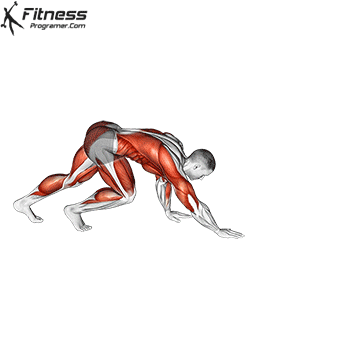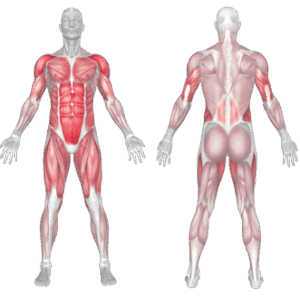Overview
The bear crawl is a functional bodyweight exercise that improves core stability, coordination, and total-body strength. It’s a quadrupedal locomotion model where you move forward (or backward) on your hands and feet while keeping your knees off the ground.
This low-impact movement challenges muscles from shoulders to hips while promoting better movement control. It mimics the natural contralateral movement pattern seen in crawling and is often used in athletic warm-ups, military-style training, mobility drills, functional fitness, and conditioning workouts.
How to do perform Bear Crawl

Begin on all fours, with hands under shoulders and knees under hips.
Lift your knees slightly off the ground, keeping them bent about 2–3 inches above the floor.
Brace your core and maintain a flat back throughout the movement.
Move forward by stepping your right hand and left foot forward simultaneously, then your left hand and right foot.
Continue for the desired distance, keeping hips low and body aligned.
Tips for Proper Form
Keep knees close to the ground for optimal core engagement.
Move slowly and deliberately to control your body position.
Maintain a neutral spine, avoiding any sagging or arching.
Minimize torso rotation for better core activation.
Breathe steadily to maintain tension without fatigue.
Common Mistakes
Hips rising too high, which reduces core involvement.
Losing alignment, causing the spine to sag or twist.
Moving too quickly, sacrificing control and stability.
Letting knees drift too far forward or out from under the hips.
Not bracing the core, leading to poor control and compensation.
Benefits of the Bear Crawl
Improves Core Stability: Engages deep abdominal muscles and spinal stabilizers through dynamic movement.
Enhances Coordination: Contralateral movement patterns sharpen brain-body connection and neuromuscular control.
Strengthens Shoulders and Hips: Builds joint stability and endurance in both the upper and lower body.
Promotes Functional Mobility: Improves movement mechanics useful in sports, crawling, or obstacle training.
Increases Conditioning and Endurance: When performed for distance or time, it challenges muscular and cardiovascular systems.
Requires No Equipment: Can be done anywhere as part of a warm-up, workout, or rehab program.
Great for All Fitness Levels: Easy to regress or progress based on speed, distance, or elevation.
How to Incorporate Into Your Routine
- For Beginners: Start with 2–3 sets of 10–15 meters at a controlled pace, focusing on form.
- For Strength and Core Control: Use 3–4 sets of 20 meters, prioritizing posture and tension.
- For Functional Training: Use in athletic drills, animal flow sessions, or agility-based warm-ups.
- For Endurance: Do longer distance bear crawls with weight bags.
- For Circuit Training: Include as a transitional movement between upper and lower body sets.
- For Fitness programs: Add into your warm-up for joint prep and neural activation.
- For Mobility and Rehab: Use slower, shortened movements to improve hip, shoulder, and spinal coordination.
Bear Crawl Muscles Worked

Frequently Asked Questions
Is the bear crawl a core or full-body movement?
Both. It primarily targets the core but also works shoulders, hips, and stabilizers.
Can I crawl backwards or sideways?
Yes. Backward and lateral crawls add variety and challenge different motor patterns.
How long should I bear crawl?
Start with 10–15 meters or 15–30 seconds. Increase as strength and endurance improve.
Is it safe for people with wrist issues?
Modify by using fists or handles to reduce wrist strain, or limit duration.
Can I use the bear crawl as a cardio exercise?
Yes. Longer crawls at a faster pace provide a metabolic challenge while reinforcing form.
